Challenges in managing the thermal balance in car compartments
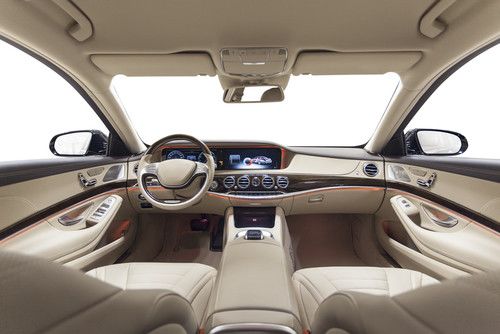
Thermal passenger comfort is an increasingly important topic in designing modern cars. To make imformed decisions concerning the HVAC layout the engineer first needs to understand the heat transfer mechanisms primarily responsible for cabin temperature and humidity. Simulations made with THESEUS‑FE support the thermal engineer by providing insight into the interplay of different environmental conditions, material properties and climatization effect. Extreme conditions such as a cold winter day in northern countries or a clear sunny day in tropical regions are easily applied by changing a few model parameters. Standard load cases specified by national or international regulation are easily defined.
For car climatization THESEUS‑FE treats all major heat transfer mechanisms that influence cabin temperature and humidity:
- heat transfer by conduction within solid parts
- heat transfer by thermal radiation between surfaces
- heat transfer by convection between solid surfaces and environment/cabin air
Integrating THESEUS-FE in full-vehicle thermal analysis simulations
THESEUS-FE can easily be integrated in full-vehicle thermal simulation. One way - and probably the easiest one - is to use interfacing software TISC from TLK-Thermo GmbH.
The video demonstrates, how easy it is to prepare models in THESEUS-FE to exchange data trough TISC with coupling partners.
Typically in this scenario, THESEUS-FE simulates a 3D car model including all thermal physical effects acting on the car cabin. These include solar radiation, surface-to-surface radiation inside the cabin, convection on the outside caused by wind and/or driving speed and so on. For quick response times, often coarse meshes like the one used in the demonstration video are used. However, for detailled analyses, typical fine meshes with element number ranging in the millions can be used as well.
Thermal Conduction in Car Cabins
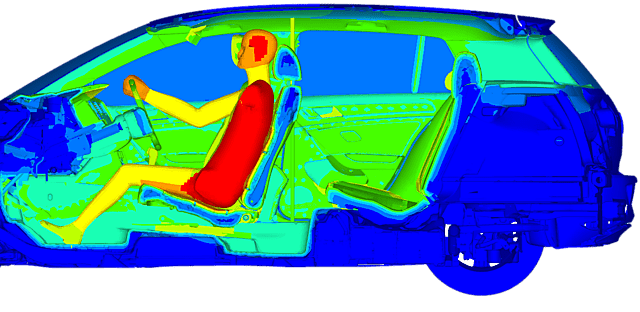
Cabins of modern cars are already well insulated thermally. As an example, consider a cross section through the complex layers in a typical car roof. Below the visible outer sheet material various layers are used for thermal insulation, noise protection and hollow spaces filled with air. Together with novel high-tech paints and coatings, this multi-layered composite buildup yields high insulation rates. These advances in insulation technologies of cars are the result of decades of research supported by simulation tools.
Nowadays, the biggest losses through thermal conduction occur through the windows. In comparison to that the remaining parts of the car cabin are already highly insulated.
Thermal Radiation in Car Cabins
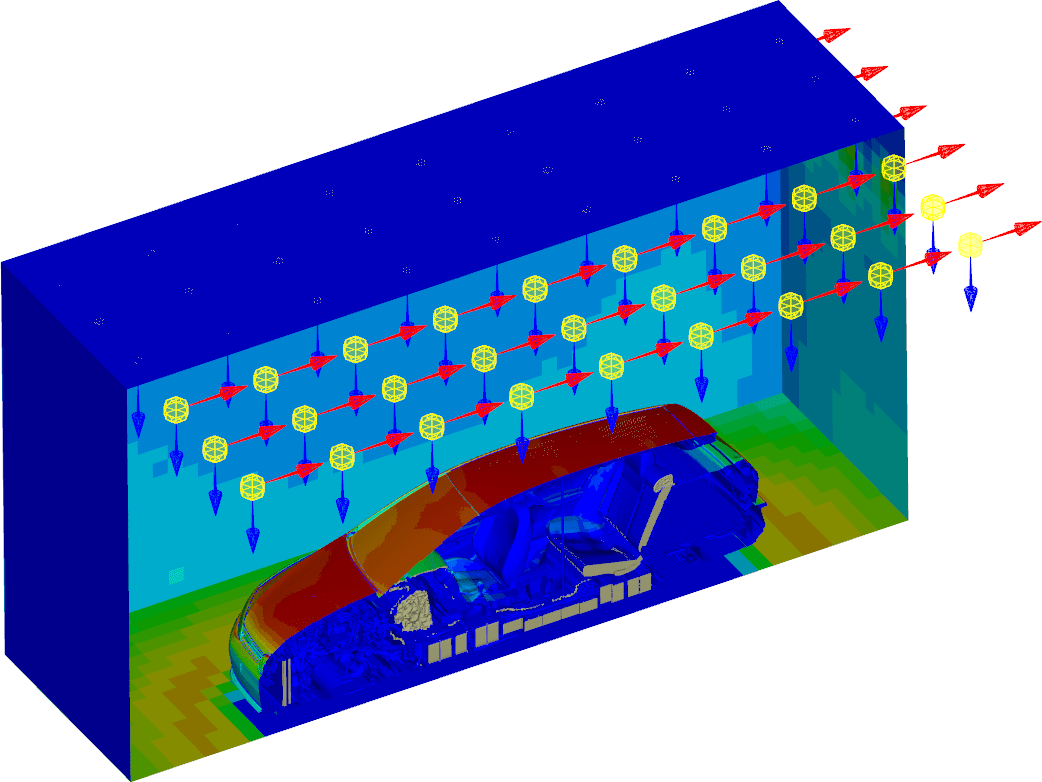
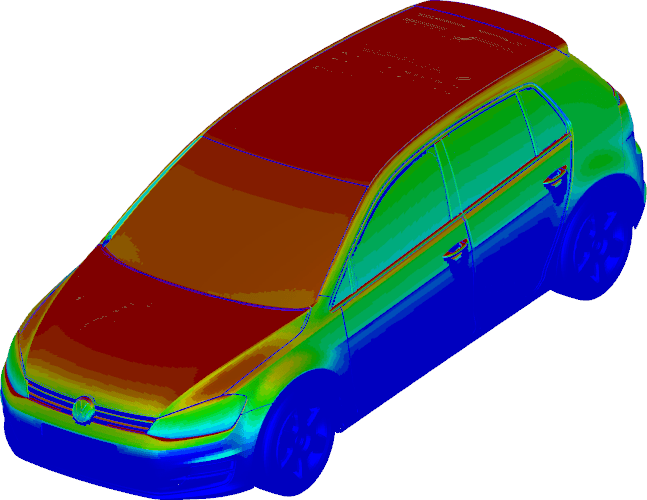
Based on their wave-lenght and energy properties as well as their origin, two types of thermal radiation can be distiguished.
Long-wave thermal radiation (> 2 µm)
The infrared portions of thermal radiation heat exchange are commonly called "long-wave radiation". Within a car cabin all component parts exchange thermal radiation energy. A difference in temperature leads to a net radiative heat exchange seeking to equalize the temperatures. Besides this heat balancing between the components themselves, the cold sky withdraws energy from the outer car surfaces through long-wave radiation.
Short-wave thermal radiation (< 2 µm)
The visible parts of thermal radiation are gathered under the term "short-wave radiation" in THESEUS‑FE. Regarding the thermal simulation of cars, the sources for this type or radiation are mainly the sun or some other light sources. Solar radiation enters the cabin by transmission through the windows and is reflected and absorbed by opaque surfaces within the cabin. During a cold winter day this takes some burden from the HVAC system and works towards heating up the compartment. In contrast to this on a hot summer day the HVAC system has to counteract this additional energy input by cooling.
To achieve simulation results that are as close to reality as possible, THESEUS‑FE uses radiation models and material properties that are wave-length dependent. This effect is essential for car windows since the radiation transmitted through the glazing has a large influence on the heat balance of the cabin.
Convective Heat Transfer in Car Cabins
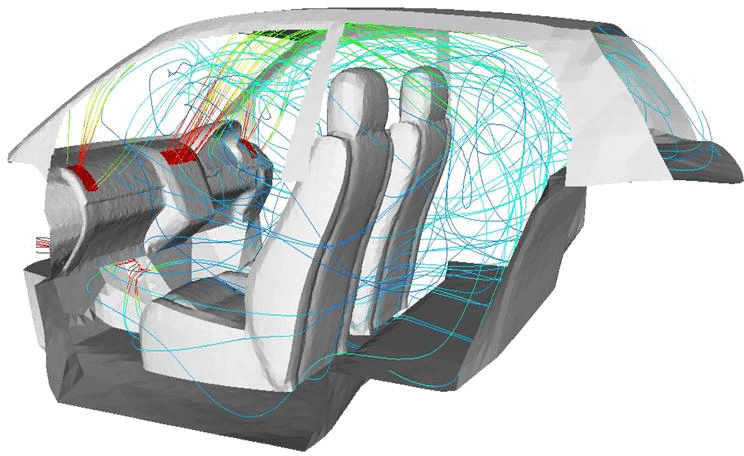
The air flow within the car cabin, when actively driven by the HVAC system, acts as a transport mechanism for heat between components. The technical term used for this effect is "forced convection". "Free convection" on the other hand occurs when a (buoyancy-driven) air flow arises solely through a difference in component temperatures and surrounding air. For example, this is observed in summer conditions when the dash board is heated to above cabin air temperature by the sun. Hot air at the material surface has a lower density than the surrounding air and rises as a consequence. For more accurately predicting flow patterns by simulation, THESEUS‑FE simulations can be coupled to a CFD solver (for example OpenFOAM or Star-CCM+). The Coupler module, part of the THESEUS‑FE suite, allows users to define and carry out co-simulation studies with a minimum of hassle.
Related publications available as free download
A real time numerical analysis of vehicle cool-down performance
[english, 6.6 MB]
H.R. Shim, H. Pastohr
Hyundai Motor Company, P+Z Engineering
VTMS 8 (Vehicle Thermal Management Systems Conference and Exhibition) | May 20-24, 2007 | Nottingham, UK
The Influence of the Solar Radiation on the Interior Temperature of the Car
[english, 0.6 MB]
C. Neacşu, M. Ivanescu, I. Tabacu
SC Auto Chassis International, University of Piteşti
2009
An Optimised Thermal Design and Development Process for Passenger Compartments of Vehicles
[english, 1.4 MB]
P. J. Baker, M. D. Jenkins, S. Wagner, M. Ellinger
Flowmaster Limited, P+Z Engineering
EASC 2009 (European Automotive Simulation Conference) | July 06-07, 2009 | Munich, Germany
Idealisierte energetisch-analytische Abbildungsmethode der Temperaturschichtung bei der passiven Aufheizung in der Fahrzeugkabine
[german, 0.5 MB]
S. Wagner
P+Z Engineering
6. Tagung PKW-Klimatisierung | November 24, 2009 | Munich, Germany
Idealisierte energetisch-analytische Abbildungsmethode der Temperaturschichtung bei der passiven Aufheizung in der Fahrzeugkabine
[german, 0.8 MB]
S. Wagner
P+Z Engineering
November 24, 2009
Einfluss der regionalen Solarstrahlung auf den Pkw
[german, 0.3 MB]
M. Westerloh, J. Köhler
Volkswagen AG, TU Braunschweig
18. SIMVEC 2016 | November 22, 2016








